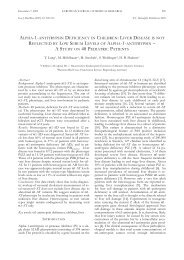European Journal of Medical Research - Deutsche AIDS ...
European Journal of Medical Research - Deutsche AIDS ...
European Journal of Medical Research - Deutsche AIDS ...
You also want an ePaper? Increase the reach of your titles
YUMPU automatically turns print PDFs into web optimized ePapers that Google loves.
June 27, 2007 EUROPEAN JOURNAL OF MEDICAL RESEARCH<br />
123<br />
phase <strong>of</strong> infection, their importance has remained unclear so<br />
far. Studies <strong>of</strong> CD8 T cell responses based on interferon-g<br />
production have shown persistence <strong>of</strong> these in progressive infection<br />
and failed to demonstrate a difference between controllers<br />
and progressors. We therefore studied different effector<br />
functions as well as activation status, proliferation capacity<br />
and apoptosis markers <strong>of</strong> CD8 T cell responses in individuals<br />
at different stages <strong>of</strong> HIV infection.<br />
Methods: 28 subjects with chronic, untreated HIV infection<br />
stratified into 5 groups according to viral load were studied.<br />
Intracellular cytokine staining using synthetic peptides as<br />
antigenic stimulus was used to study production <strong>of</strong> interferong,<br />
TNF-a and IL-2. Tetramer staining was used for content <strong>of</strong><br />
perforin and granzyme B as well as CD38, HLA-DR, CD57,<br />
Ki67, cell cycle analysis, Bcl-2 and CD95.<br />
Results: We did not find a significant difference between the<br />
five groups for antigen specific production <strong>of</strong> interferon-g,<br />
TNF-a and IL-2. Neither was there a difference in granzyme<br />
B and perforin content as outread for the effector function cytolysis.<br />
We found highly significant differences between controllers<br />
and the four progressor groups for immune activation<br />
by CD38 staining (p < 0.05 for all groups) with a<br />
VL>200,000 cp/ml having the most CD38 positive cells. The<br />
difference was even more pronounced for HIV specific CD8<br />
T cells than for bulk CD8 T cells (p < 0.05). Immune activation<br />
<strong>of</strong> HIV specific cells according to CD38 was correlated<br />
with viral load (r2 = 0.51, p < 0.0001) and inversely correlated<br />
with CD4 counts (r2 = 0.52, p < 0.0001). We then failed to<br />
find differences between markers for cell proliferation as well<br />
as for protection <strong>of</strong> apoptosis (Bcl-2) or death receptors<br />
(CD95) <strong>of</strong> HIV specific cells.<br />
Conclusion: Our study showed a highly significant difference<br />
in immune activation as outlined by CD38 staining. But neither<br />
enhanced proliferation nor the aptitude for apoptosis can<br />
explain the consequences <strong>of</strong> immune activation and therefore<br />
the reason for the difference in immune activation between<br />
controllers and progressors.<br />
F.12 (Vortrag)<br />
Interleukin-2 augments dendritic cells numbers in<br />
lymphoid tissue<br />
Stellbrink H.-J. 1 , Tenner-Racz K. 2 , van Lunzen J. 3 ,<br />
Schneider C. 4 , Racz P. 2<br />
1 ICH Hamburg, Hamburg, Germany, 2 Bernhard-Nocht-<br />
Institut, Abt. für Pathologie, Hamburg, Germany,<br />
3 Ambulanzzentrum des Universitätsklinikums Hamburg-<br />
Eppendorf, Bereich Infektiologie, Hamburg, Germany,<br />
4 Universitätsklinikum Hamburg-Eppendorf, Klinik und<br />
Poliklinik für Allgemein-, Viszeral- und Thoraxchirurgie,<br />
Hamburg, Germany<br />
Background: Autologous dendritic cells have been used for<br />
therapeutic vaccination in HIV infected individuals. IL-2 represents<br />
a potential adjuvant for therapeutic vaccination in this<br />
setting. We therefore investigated if HAART +/- IL-2 impacts<br />
on immature (CD1a+ or CD207 [Langerin]+) as well as mature<br />
(CD208 [DC-LAMP]+ or CD83+) dendritic cell numbers<br />
in the lymphoid tissue.<br />
Methods: 15 chronically HIV-1 infected, antiretroviral naive<br />
subjects (group 1: HAART, n=8; group 2: HAART + interleukin-2,<br />
n=7; all male) were enrolled in a prospective, randomised,<br />
controlled clinical trial on HAART +/- IL-2 (COS-<br />
MIC). Serial axillary lymph node biopsies were performed at<br />
baseline and after at least six months <strong>of</strong> undetectable plasma<br />
viremia. Subjects were selected according to the availability<br />
<strong>of</strong> suitable frozen tissue for the analysis. CD1a+ or Langerin+<br />
immature as well as CD83+ or DC-LAMP+ mature DCs were<br />
detected on frozen sections by immunohistochemistry. They<br />
were enumerated by PC-based image analysis and expressed<br />
as cells per unit area, based on the analysis <strong>of</strong> 10 non-overlapping<br />
fields. Results were analysed by t-test, Mann-Whitney U<br />
test, and MANOVA, where appropriate.<br />
Results: Peripheral blood CD4+ T cells were 603 ±165 and<br />
477 ± 176 in groups 1 and 2, resp. (p=n.s.) Plasma viremia<br />
was 4.3 ±0.61 and 4.53 ± 0.55 log10, resp. (p=n.s.). CD4+<br />
cells increased in both groups (p=0.00004) and were higher in<br />
the IL-2 group 2 at the 2nd biopsy (p=0.04, MANOVA). Time<br />
on treatment until 2nd biopsy (370 vs. 365 days) did not differ<br />
between the groups (p=0.86, t-test). Baseline CD1a+ and DC-<br />
LAMP+ cell numbers were higher in group 2 (p=0.0031 and<br />
0.04, resp., t-test). CD1a+, Langerin+, DC-LAMP+, and<br />
CD83+ cells increased in both groups (all p





